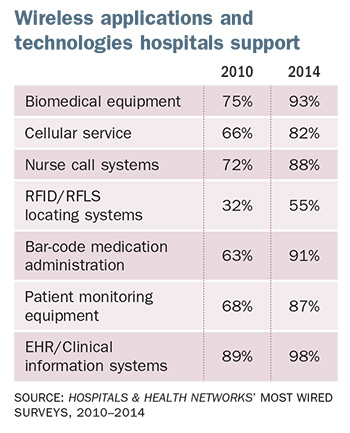 As hospitals and health systems continue to leverage technology to improve clinical and business operational performance, they're leaning more heavily than ever on wireless applications and infrastructure. And as data from the recently released 16th annual Hospitals & Health Networks' Most Wired Survey indicate, electronic health records (EHRs), wireless biomedical equipment and bar-code medication administration are largely ubiquitous across the country.
As hospitals and health systems continue to leverage technology to improve clinical and business operational performance, they're leaning more heavily than ever on wireless applications and infrastructure. And as data from the recently released 16th annual Hospitals & Health Networks' Most Wired Survey indicate, electronic health records (EHRs), wireless biomedical equipment and bar-code medication administration are largely ubiquitous across the country.
Trend line data from the Most Wired survey indicate that over the past five years, the percentage of hospitals implementing EHRs swelled from 89 percent in 2010 to 98 percent in 2014. Meanwhile, 93 percent of organizations responding to the 2014 survey deploy wireless biomedical equipment, up sharply from 75 percent in 2010. Bar-code medication administration, which supports greater accuracy in dispensing medications to patients, likewise rose sharply from 63 percent in 2010 to 91 percent in 2014.
Elsewhere, significant increases were found in the percentage of organizations with cellular service, wireless nurse call systems, wireless patient monitoring equipment and radio-frequency identification (RFID) systems to aid in asset and patient tracking.
The percentage of organizations with cellular service capabilities soared from 66 percent in 2010 to 82 percent this year. Similar gains were witnessed in the percentage of organizations with wireless capabilities for patient monitoring equipment, up from 68 percent in 2010 to 87 percent in 2014. The percentage of organizations deploying RFID, meanwhile, nearly doubled between 2010 and 2014, with 55 percent of organizations now using this technology.
In terms of how hospitals are supporting their wireless communications, 30 percent of survey respondents have a single, unified enterprisewide wireless infrastructure that runs at least 75 percent of the applications. Nearly two out of three respondents (65 percent) employ a single, unified enterprisewide, medical-grade, wireless infrastructure that runs clinical and other applications at 99.9999 percent reliability.
A medical-grade, wireless infrastructure guarantees wireless coverage throughout a facility to support the use of multiple applications and devices such as pagers, two-way radios, wireless patient monitoring, Wi-Fi, Voice over Internet Protocol and cellular phones.





